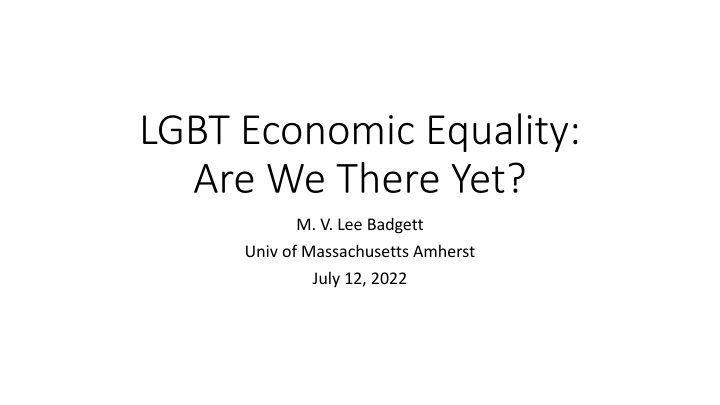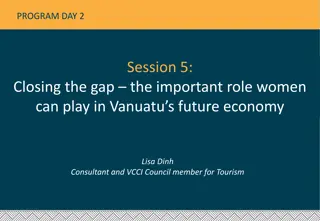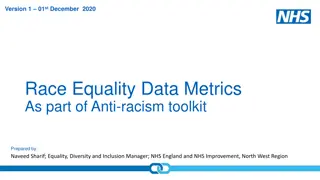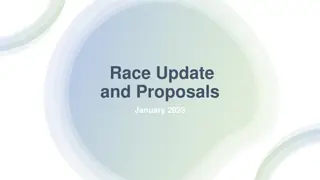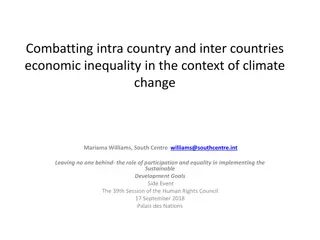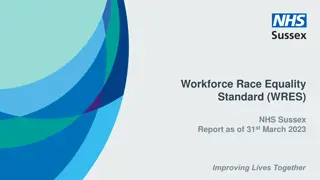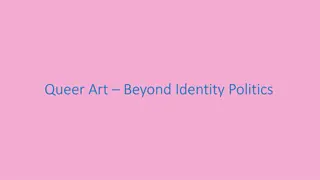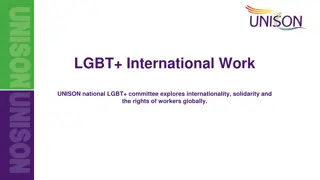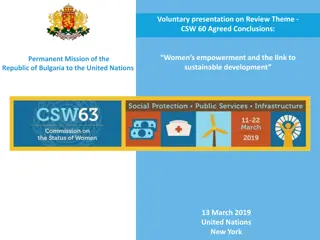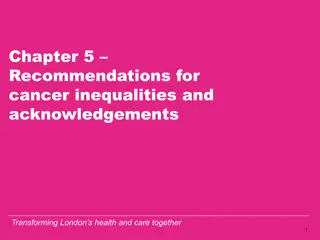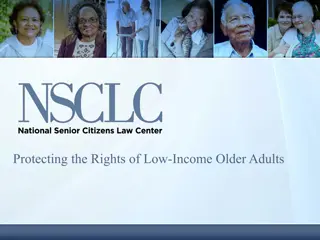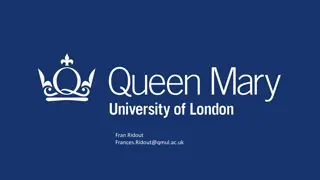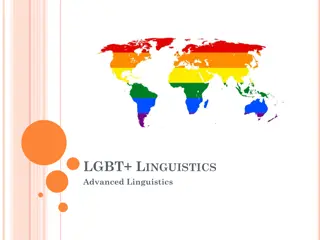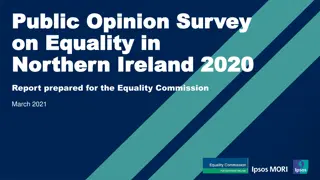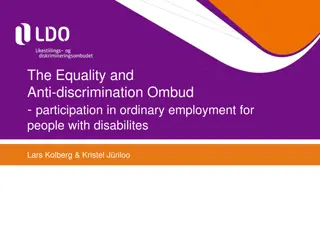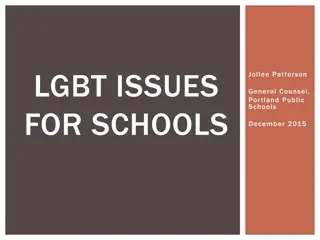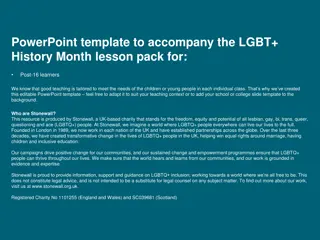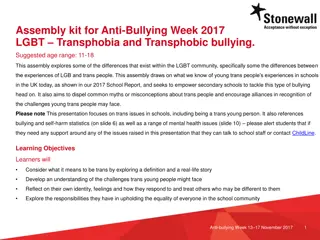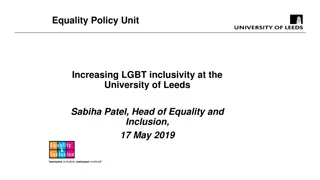Challenges in Achieving LGBT Economic Equality
Progress on LGBT rights is evident, but economic disparities persist within the community. Factors like discrimination contribute to wage gaps and hinder financial well-being. More data and efforts are needed to address these issues and promote equality.
Download Presentation

Please find below an Image/Link to download the presentation.
The content on the website is provided AS IS for your information and personal use only. It may not be sold, licensed, or shared on other websites without obtaining consent from the author.If you encounter any issues during the download, it is possible that the publisher has removed the file from their server.
You are allowed to download the files provided on this website for personal or commercial use, subject to the condition that they are used lawfully. All files are the property of their respective owners.
The content on the website is provided AS IS for your information and personal use only. It may not be sold, licensed, or shared on other websites without obtaining consent from the author.
E N D
Presentation Transcript
LGBT Economic Equality: Are We There Yet? M. V. Lee Badgett Univ of Massachusetts Amherst July 12, 2022
Progress on rights Plus side: Marriage equality Protections against employment discrimination Negative side: Still can t pass Equality Act Attacks on trans youth Supreme Court threat on criminalization and marriage equality
But lived experience? No, we are not there! Worse economic outcomes Disadvantages vary within LGBT community Driven by discrimination How exclusion also hurts our economy Need for more data
Wage gaps for LGB people (holding all else equal) Gay/bi men Klawitter (2015): 11% less Drydakis (2022): 7% less for gay men, 10% less for bi men Lesbian/bisexual women Klawitter: 9% higher earnings Drydakis: 7% higher for Ls, 10% lower for B women BUT: All women earn less than GBH men Why negative? Discrimination (bigger gap where most negative attitudes; smaller gap where laws) Why? More observable experience More unobservable experience?
Wage gaps for LGB people (holding all else equal) Gay/bi men Klawitter (2015): 11% less Drydakis (2022): 7% less for gay men, 10% less for Lesbian/bisexual women Klawitter: 9% higher earnings Drydakis: 7% higher for Ls, 10% lower for B women BUT: All women earn less than GBH men Why? Discrimination (bigger gap where most negative attitudes; smaller gap where laws) Why positive? More observable experience More unobservable experience?
Wage & income gaps: Transgender people Moving from pre-transition to post-transition (US, Netherlands): Trans women s earnings fall Trans men s earnings don t change much Transgender effect + or gender effect Household income lower for trans people in US BRFSS: FTM have larger income gap than MTF; no gap for gender nonconforming (Carpenter et al 2020) Household Pulse: lower for trans women and for those not identifying with gender binary labels (relative to ciswomen) (Carpenter et al, 2022) Earnings 14%-18% lower for trans people comparing USTS to ACS (Shannon 2021)
Panel B: Men. With demographic controls and state fixed-effects. Persistent negative gap Badgett, Carpenter, Sansone 2020
Panel A: Women. With demographic controls and state fixed-effects. Positive diff disappearing Badgett, Carpenter, Sansone 2020
Poverty rates by SOGI (BRFSS; Badgett et al 2019) Trans men 33.7% Trans women 29.6% GNC 23.8%
A word on COVID: worse worse Higher level of financial problems (paying rent, affording basics) Higher levels of food insecurity: 13% LGBT vs 7% nonLGBT More layoffs, loss of hours, lost income Delayed medical care Safety issues at work https://www.census.gov/library/stories/2021/08/lgbt-community-harder-hit-by-economic-impact-of-pandemic.html
Effects of intersectionality in wages & poverty Gender: assigned female at birth have worse measures Race & ethnicity: white LGBT people better off than LGBT people of color Cis-het people of color better off than LGBT people of color
Does discrimination explain wage gaps and higher poverty rates? Likely contributor Likely contributor
Self-reported discrimination 30% of LGBT employees report being fired or not hired bc of SOGI (in lifetime) 49% of transgender employees 28% of cisgender LGB employees 29% of LGBT persons of color, 18% of white LGBTs 40% experienced discrim or harassment 57% of discrim/harassment motivated by religious beliefs 50% not out to supervisor, 26% not out to any coworkers https://williamsinstitute.law.ucla.edu/wp-content/uploads/Workplace-Discrimination-Sep-2021.pdf
Experiments in hiring process show discrim 18 + studies in OECD countries Flage (2020): 35% lower odds of getting called for an interview for LGB-coded applicants Studies of transgender people in NYC, Sweden, Malaysia, Singapore, Thailand, and Vietnam show lower odds for transgender workers, too Include on resume: Gender identity: changes in names, pronouns Sexual orientation: relevant job experience in LGB organization at University; same-sex partner; explicit identity on social media
Role of discrimination in higher rates of poverty 93 LGBTQ people living in poverty Los Angeles Co n=60 Kern Co n=33 Wilson et al, 2020
Pathways out of poverty: Intergenerational poverty especially important for LGBT people of color, so pathway out is harder Barriers to getting and keeping jobs: health, discrimination; linked to disclosure of SOGI status Opportunities for low quality jobs: Low wage, less stable Resources for getting jobs are limited
Human capital & economic potential Education Employment Health Businesses LGBTI INCLUSION ECONOMIC OUTPUT FOR COUNTRIES
Latest Business Case Research Latest Business Case Research More LGBT-positive policies lead to: Higher stock prices Higher profits Higher productivity Attracting more creative workforce
Econometric findings Emerging Economies One additional right + $320 GDP per cap (3%)
Econometric findings 133 countries One additional right + $2065 GDP per cap
The power of making an Economic Case Complements human rights arguments we need both Opens doors Business & Financial sector Development banks & agencies Actions Push for inclusive laws & policies Direct efforts in economic empowerment Better data to measure & monitor progress
A final word: Data Data Big samples to look at intersectionality More SOGI questions Questions about intersex status Workplace questions Employer-level data: representation in hiring, promotions
